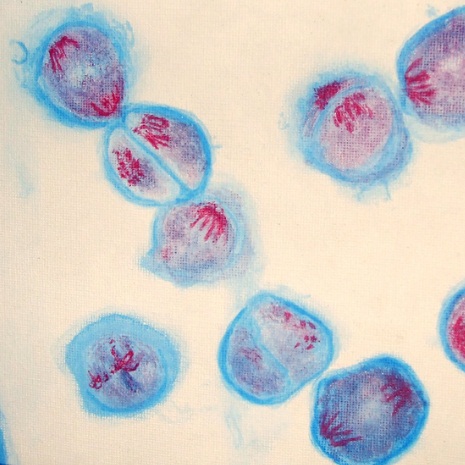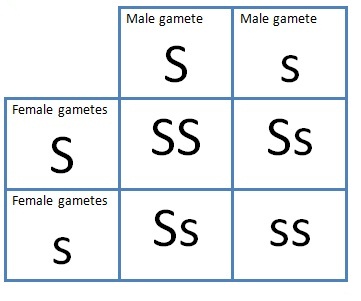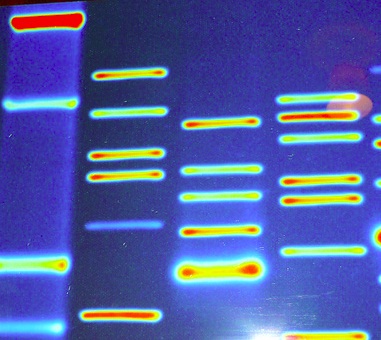Topic 3 - Genetics SL revision list
This pages gives outline details of the content of the topic together with essential questions and student skills and applications. Helpful for revision.
3.1 Genes
- Definition of a gene is, "a heritable factor that consists of a length of DNA and influences a specific characteristic."
- A gene locus is, "the specific position of a gene on a chromosome."
- Alleles are, "The various specific forms of a gene which differ from each other by one or only a few bases".
- New alleles are formed by mutation.
- A genome is, "the whole of the genetic information of an organism."
- The entire base sequence of human genes was sequenced in the Human Genome Project.
- The Genbank® database can be used to search for DNA base sequences.
Essential Questions 
- What is the difference between a gene, a gene locus, a genome and alleles?
- Where do all the different alleles come from?
- What is the benefit of the human genome project to genetics?
- How can databases be used by biologists in the face of all this new genome data?
Skills ( can you ... )
- Explain the causes of sickle cell anemia, including a base substitution mutation, subsequent change to the mRNA transcribed from it and a change to the sequence of amino acids in a polypeptide of hemoglobin.
- Recall of one specific base substitution that causes glutamic acid to be substituted by valine as the sixth amino acid in the hemoglobin polypeptide is required. (Deletions, insertions and frame shift mutations are not needed.)
- Compare the number of genes in humans with other species.
At least one plant and one bacterium should be included in the comparison and at least one species with more genes and one with fewer genes than a human.
(note: "genome size" is total amount of DNA, not the number of genes in a species) - Use of a database to determine differences in the base sequence of a gene in two species. Look up "GENBANK"
3.2 Chromosomes
- Prokaryotes have one single circular DNA molecules as a chromosome.
- Some prokaryotes also have plasmids but eukaryotes don't.
- Eukaryote chromosomes are linear DNA molecules associated with histone proteins.
- In a eukaryote species there are a characteristic number of different chromosomes each carrying different genes.
- Pairs of chromosomes with the same sequence of genes (not necessarily the same alleles) are "Homologous chromosomes"
- Diploid nuclei have pairs of homologous chromosomes.
- Haploid nuclei have one chromosome of each pair.
- Sister chromatids are the two DNA molecules formed by DNA replication before cell division
- two separate chromosomes are formed at the splitting of the centromere at the start of anaphase.
- A karyogram (a chart) shows the chromosomes of an organism in homologous pairs of decreasing length. (Karyotype is the number and type of chromosomes present in the nucleus)
- Sex chromosomes determine the gender of an individual and autosomes are chromosomes that do not determine sex.
Essential Question(s) 
- How is the DNA arranged in prokaryotes and eukaryotes?
- How many chromosomes does a eukaryote have, are all species the same?
- Do chromosomes occur in pairs? Why?
- Distinguish between diploid cells and haploid cells?
- What is the difference between "X" shaped double stranded chromosomes and "I" shaped single stranded chromosomes?
Skills (can you ....)
- Understand Cairns’ technique for measuring the length of DNA molecules by autoradiography.
- Compare genome size in T2 phage, Escherichia coli, Drosophila melanogaster, Homo sapiens and Paris japonica. (selected for points of interest.Genome size comparative activity
- Use karyograms to compare diploid chromosome numbers of Homo sapiens, Pan troglodytes, Canis familiaris, Oryza sativa, Parascaris equorum.
- Use karyograms to deduce sex and diagnose Down syndrome in humans.
- Use of databases to identify the locus of a human gene and its polypeptide product
3.3 Meiosis
- Meiosis produces four haploid nuclei from one diploid nucleus.
- Haploid nuclei allow a life cycle with fusion of gametes.
- DNA is replicated before meiosis so that all chromosomes at start of meiosis are 'double stranded' with two sister chromatids.
- The early stages of meiosis involve pairing of homologous chromosomes and crossing over followed by condensation.
- Random orientation of pairs of homologous chromosomes.
- Separation of pairs of homologous chromosomes in the first division of meiosis halves the chromosome number.
- Genetic variation is the result of crossing over and random orientation.
- Different parents providing gametes promotes genetic variation.
Essential Question(s) 
- What happens inside a cell to form double stranded chromosomes?
- How does meiosis lead to variation in gamete alleles?
- Why does random orientation of homologous chromosomes promote variation?
- How does sexual reproduction lead to variation in offspring?
Skills ( can you ...)
- Seen how non-disjunction can cause Down syndrome and other chromosome abnormalities.
- Seen studies showing age of parents influences chances of non-disjunction.
- Describe methods used to obtain cells for karyotype analysis e.g. chorionic villus sampling and amniocentesis and the associated risks.
- Skill: Drawing diagrams to show the stages of meiosis (possibly using prepared slides), and resulting in the formation of four haploid cells. (Chiasmata not required)
3.4 Inheritance
- Mendel experiments with pea plants showing his rules of inheritance.
- Gametes are haploid so contain only one allele of each gene.
- The two alleles of each gene separate independently during meiosis.
- Fusion of gametes results in diploid zygotes with two alleles of each gene.
- Dominant alleles mask the effects of recessive alleles but co-dominant alleles have joint effects.
- Many genetic diseases in humans are due to recessive, dominant or co-dominant alleles of autosomal genes.
- Some genetic diseases are sex-linked, shown as superscript letters eg. Xh. The pattern of inheritance is different due to their location on sex chromosomes.
- Many genetic diseases have been identified in humans & most are very rare.
- Radiation and mutagenic chemicals increase the mutation rate and can cause genetic diseases and cancer.
Essential Question(s) 
- How are alleles passed from parents to offspring?
- How do alleles get assorted into gametes in meiosis?
- What is different about dominant alleles and co-dominant alleles of a gene?
- Why are some alleles recessive?
- Why do men more often show phenotypes of genetic dieseases like colour blindness and haemophilia than women?
- What causes new alleles to form?
Skills (can you ....)
- Explain the inheritance of ABO blood groups.using IA, IB or i allele notation.
- Explain inheritance of red-green colour blindness and hemophilia as examples of sex-linked inheritance.
- Explain the autosomal inheritance of cystic fibrosis and Huntington’s disease.
- Construct Punnett grids for monohybrid genetic crosses.
- Compare predicted and actual outcomes of genetic crosses using real data.
- Analyse pedigree charts and to deduce the pattern of inheritance of genetic diseases.
3.5 Genetic Modification
- Gel electrophoresis is used for the separation of fragments of DNA (or proteins).
- PCR (polymerase chain reaction) can be used to make many copies of small amounts of DNA. (called amplification)
- DNA profiling uses PCR and gel electrophoresis to compare samples of DNA (eg. in paternity disputes)
- Genetic modification is the transfer of genes from one species to another.
- Clones are groups of genetically identical organisms, derived from a single original parent cell.
- Many plant species and some animal species have natural methods of cloning.
- Animals can be cloned at the embryo stage by breaking up the embryo into more than one group of cells. or by using differentiated cells in adults.
- The cloned sheep, Dolly can be used as an example of the cloning method of somatic-cell nuclear transfer.
Essential Question(s) 
- Why do larger DNA molecules move more slowly through a gel than small ones?
- DNA polymerase is the enzyme used in PCR, what does it do once the DNA strands separate after heating?
- Why do different people have different sizes of DNA fragments when the same enzymes break their DNA into pieces?
- The DNA code is "universal" how does this help gene transfer?
- Why do we call both twins and plant cuttings clones?
- What are the risks and benefits of planting a hedge made from cuttings of the same tree?
Skills (can you ....)
- Use images of DNA profiling to solve paternity disputes and other forensic examples.
- Explain that Gene transfer using plasmids in bacteria makes use of the enzymes; restriction endonucleases and DNA ligase.
- Assess the potential risks and benefits of GMO crops, including data on risks to monarch butterflies of Bt crops.
- Design of an experiment to assess one factor affecting the rooting of stem-cuttings of a plant which easily produces roots in soil.

 IB Docs (2) Team
IB Docs (2) Team
